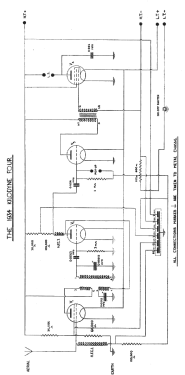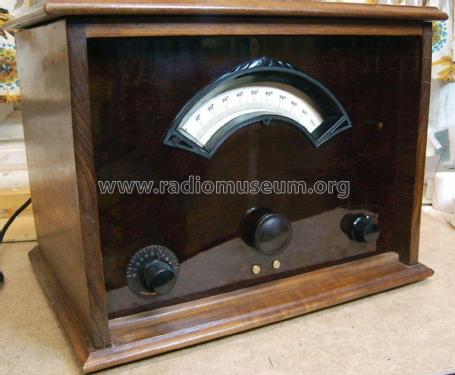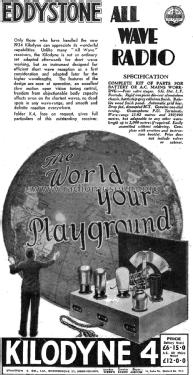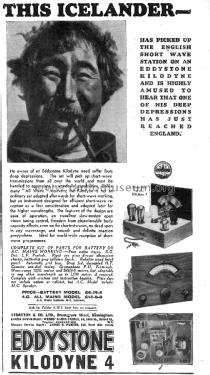Kilodyne Four 1934 Battery
Eddystone (Brand), Stratton and Co., Ltd., Eddystone Radio Ltd.; Birmingham
- Pays
- Royaume Uni
- Fabricant / Marque
- Eddystone (Brand), Stratton and Co., Ltd., Eddystone Radio Ltd.; Birmingham
- Année
- 1933
- Catégorie
- Boîte de construction (composants et manuel) ou instructions
- Radiomuseum.org ID
- 111461
Cliquez sur la vignette du schéma pour le demander en tant que document gratuit.
- No. de tubes
- 4
- Principe général
- Récepteur TRF - par réaction (régénératif); Tube à grille écran 1926-1935.
- Gammes d'ondes
- PO et OC
- Tension / type courant
- Piles (rechargeables ou/et sèches) / 2 / 148 Volt
- Haut-parleur
- - Ce modèle nécessite des HP externes
- Matière
- Boitier métallique, lampes visibles
- De Radiomuseum.org
- Modèle: Kilodyne Four 1934 [Battery] - Eddystone Brand, Stratton and
- Forme
- Chassis (pour intégration dans meuble)
- Remarques
-
Only those who have handled the new 1934 Kilodyne can appreciate its wonderful capabilities. Unlike many " All Wave" receivers, the Kilodyne is not an ordinary set adapted afterwards for shortwave working, but an instrument designed for efficient short-wave reception as a first consideration and adapted later for the higher wavelengths. The features of the design are ease of operation, an excellent slow motion open vision tuning control, freedom from objectionable body capacity effects even on the shortest waves, no dead spots in any wave -range, and smooth and definite reaction everywhere.
Four-valve stages. S.G. Det. L.F. Pentode. Rigid one-piece die-cast aluminium chassis, battleship grey cellulose finish. Bakelite wood finish panel. Automatic grid bias. Drop fed, decoupled H.T. Genuine one-dial tuning. Gramophone P.U. Terminals. Wave range from 13 - 92 metres and 230 - 490 metres, but is adaptable to any other wavelength up to 2,000 metres if required. Easily assembled without soldering.
Complete with erection and instruction booklet.The circuit design is based on the 1933 Kilodyne which gave such great satisfaction, and which has been modified to include the latest developments. The design employs a screened grid high-frequency stage and although an untuned aerial circuit is used, a great measure of amplification is obtained from this valve due to the efficiency of the coupling circuit following it. This coupling comprises a high-frequency transformer with tune secondary winding, which arrangement gives only light damping on the detector valve grid circuit, to the great advantage as far as selectivity is concerned. The reaction winding is fed from the detector plate by means of the Reinartz method to this transformer. The detector valve is of the metalized type and leaky grid detection is employed. The detector valve is coupled to the first L.F. valve by means of a resistance coupling stage, the valve of which is coupled by means of a Hypermite transformer to the final pentode output valve. There are only two high-tension leads, the different voltages for the various stages being drop fed by means of resistances and decoupled, which results in more efficient working, greater simplicity, and an even drain on the high-tension battery. The grid bias battery is eliminated, automatic bias being derived from the high-tension supply for this purpose,
The receiver is sold as a kit primarily designed for shortwave reception, with optional (2,5" vertical plug-in type) coils also MW.
Price 6£ 5s 6d plus valves, batteries, and speaker, complete price £9 1s 0d.Also available as an AC version.
- Prix de mise sur le marché
- 9.05 GB £
- Littérature
- Quick Reference Guide, Eddystone User Group
- Schémathèque (1)
- - - Manufacturers Literature (Eddystone Instruction Book For 1934 Kilodyne Kits)
- Schémathèque (2)
- -- Original prospect or advert (World Radio Dec 22, 1933, Page 859.)
- Auteur
- Modèle crée par Martin Bösch. Voir les propositions de modification pour les contributeurs supplémentaires.
- D'autres Modèles
-
Vous pourrez trouver sous ce lien 256 modèles d'appareils, 127 avec des images et 46 avec des schémas.
Tous les appareils de Eddystone (Brand), Stratton and Co., Ltd., Eddystone Radio Ltd.; Birmingham



